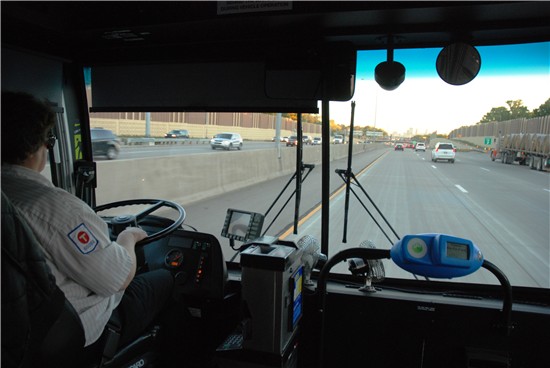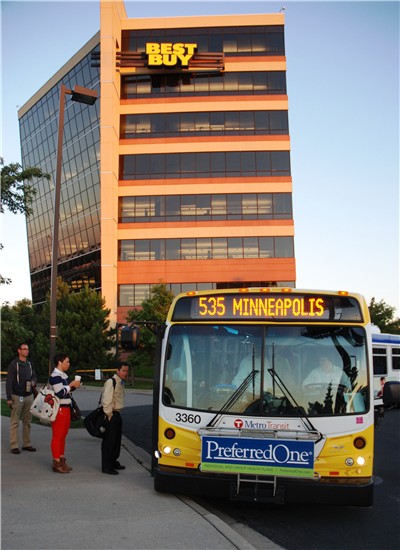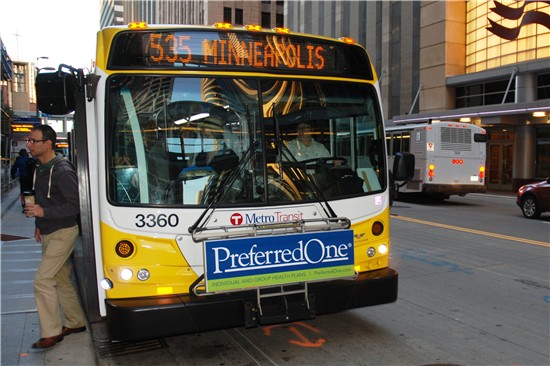
When Mary Thompson started her new job in downtown Minneapolis in September, she thought it would be easy to get in her car and go to work. It wasn’t as simple as she’d hoped.
“I drove the first two days and it was pretty undesirable,” Thompson said recently as she rode into Minneapolis aboard a Route 535 bus, her new preferred way of getting to work.
Thompson is one of many commuters from Bloomington, Richfield and south Minneapolis who have turned to Metro Transit as a way to avoid traffic headaches on Interstate 35W.
On a recent northbound, 7:04 a.m. Route 535 bus, customers going to work, class and appointments said they elected to use transit because it cuts their commute times, allows them to avoid hefty parking costs and is simply a more relaxing ride.
“It’s convenient, it’s quick and it’s consistent,” said Jeff Roy who, like Thompson, recently started a new job downtown and quickly landed on Route 535 as the best way to get to and from work.
Roy estimated it would take him more than a half-hour to get downtown if he drove. Now he simply drives a few blocks to the 525-space Knox Avenue Park & Ride near Best Buy’s Richfield headquarters and can be downtown in less than 20 minutes.
The travel-time savings come because Route 535 buses use MnPASS lanes and the Marq2 corridor, which speeds bus entries and departures out of downtown.
 Savings in time and money have proven to be an alluring pull for Route 535. In 2012, there were nearly 425,000 customer boardings – a roughly 12 percent increase from 2011’s ridership – and an average of almost 1,400 passengers per day
Savings in time and money have proven to be an alluring pull for Route 535. In 2012, there were nearly 425,000 customer boardings – a roughly 12 percent increase from 2011’s ridership – and an average of almost 1,400 passengers per day
Plans in the works now aim to make the commute even better.
The planned METRO Orange Line aims to bring frequent, all-day service to the I-35W corridor between downtown Minneapolis and Burnsville. Buses would travel north and south, serving several existing Route 535 stops, including the South Bloomington Transit Center at 98th Street, the American Boulevard area, 66th Street and Lake Street. Buses would also stop at I-35W & 46th Street Station, which opened in 2010 and is located between the freeway's northbound and southbound lanes so buses don't have to leave the roadway to pick up or drop off customers.
The system would improve service to several key destinations including the burgeoning mixed-use Penn-American District in Bloomington and the Lake Street corridor.
Orange Line station designs and locations are being completed now in the hopes of beginning construction in 2016 and opening in 2019. A series of meetings related to proposed road improvements and station layouts are being held this month in the hopes of setting a clear vision by the end of the year (find complete details about this month's meetings here).
“Orange Line BRT will better connect people across the region to job centers, housing, major transit stations, and key destinations in the corridor,” said Christina Morrison, a senior planner working on the Orange Line project. “Like the METRO Blue Line, it will greatly improve service for people who travel downtown as well as to suburban job centers while expanding transit options midday, at night, and on the weekends."
When open, the Orange Line would replace the current Route 535, improving frequency to every 10- to 15 minutes and adding new weekend service.
The planning comes almost 90 years after bus service to the southern suburbs began on Lyndale Avenue – a major highway prior to the construction of I-35W in the 1960s.
Service was initially run by the Bloomington Bus Company but was taken over by the Metropolitan Transit Commission (MTC) in 1975. Through early federal investments, the corridor became one of the first in the country to see express bus service, leading buses to move from their traditional two-speed transmissions to three-speed engines that could travel faster than 45 miles per hour.
The $133 million federal Urban Partnership Agreement led to further improvements in 2009 and 2010, including improved MnPASS lanes, NexTrip signage that provides real-time transit information, auto-to-transit real-time travel time comparisons signs and new buses.
Customer Joel Carey, who boarded at 66th Street, has ridden Route 535 to work downtown for the last three years, taking full advantage of the improvements and enjoying a 30-minute door-to-door commute. Now that he’s become a regular rider, he said there’s little chance he’d ever get back in the car again.
“Once you get used to doing this, there’s really no going back,” he said.
 Route 535 At a Glance
Route 535 At a Glance
Type: Limited Stop
Service: Route 535 travels between South Bloomington Transit Center, a 195-space Park & Ride at 98th Street and I-35W, and downtown Minneapolis. Major destinations along the route include Southtown Shopping Center at I-494 and Penn Avenue, Best Buy’s Richfield headquarters and I-35W & 46th Street Station. The C and D branches of Route 535 also serve Normandale Community College, one of the largest participants in Metro Transit's College Pass program. Route 535 buses operate between approximately 5 a.m. and midnight, weekdays only. Rush-hour frequency is approximately every 20 minutes.
Route length: Approximately 12 miles
Stops: 76 northbound, 78 southbound
Vehicles: 40-foot standard and 60-foot articulated
Ridership: Nearly 425,000 customer boardings in 2012, with an average of almost 1,400 passengers per day.
History: Bus service to the south metro began in the 1920s, when buses ran along Lyndale Avenue. Express bus service began following the construction of Interstate 35W in the 1960s and the Metropolitan Transit Commission (MTC) took over service from the Bloomington Bus Company in 1975.
Future: The planned METRO Orange Line would bring all-day, frequent bus service to the I-35W corridor. Plans call for frequent, all-day bus service between MVTA's Burnsville Transit Station and downtown Minneapolis with stops at 98th Street, near American Boulevard, 66th Street, 46th Street, Lake Street and on the Marq2 corridor downtown.